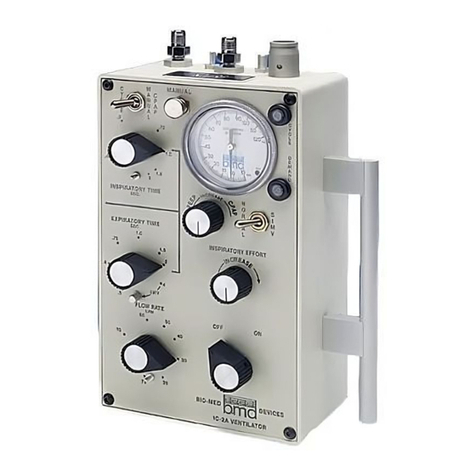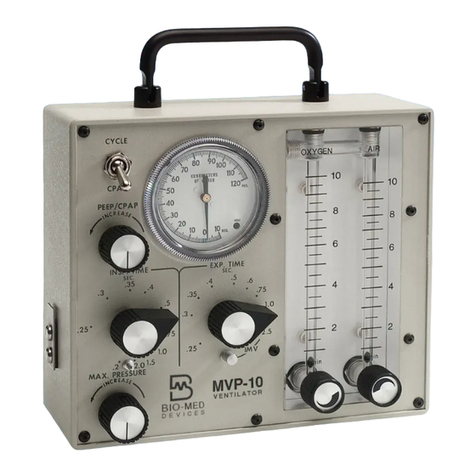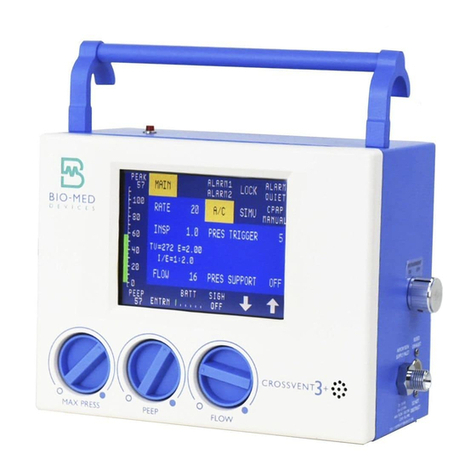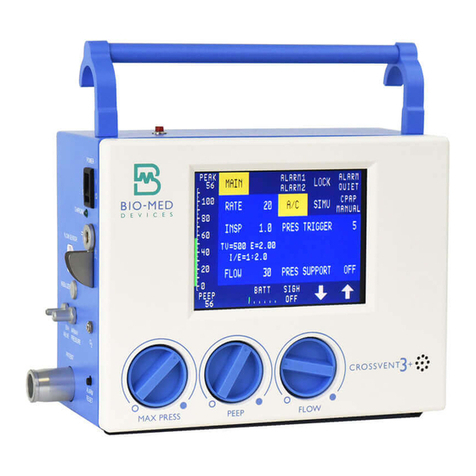
About this Manual
Bio-Med Devices, Inc. Page 18
•When using nebulization or humidification, breathing system filters and heat-and-moisture
exchangers can require more frequent replacement to prevent increased resistance and blockage.
•The accuracy of the ventilator can be affected by the gas added by use of a nebulizer.
•The TV-100 should be used while it is in an upright position.
•Do not continue to use a ventilator which has been seriously impacted or abused.
•To avoid risk of electrical shock when using the TV-100 with AC power connected, this equipment
must only be connected to a supply mains with protective earth.
•Because this is a CE marked device, the TV-100 must never be modified without prior expressed
written consent from Bio-Med Devices, Inc.
•If using this ventilator in conjunction with a humidifier, a temperature monitor with alarm must be
used if such a monitor is not a part of the base humidifier unit.
•Outside of the recommended pressure range for oxygen input of 40-90 PSI, the delivered oxygen
concentration to the patient cannot be guaranteed to remain in specification, in which case an
output delivered-oxygen limit alarm would sound. However, the dedicated alarm for low oxygen
input pressure does not activate until the input pressure falls to 29 PSI, to forestall recurring
nuisance alarms when hospital oxygen supplies are overtaxed facility-wide (e.g., in pandemic
situations). Thus when the input pressure falls outside the range 29-90 PSI, the TV-100 will display
an O2Pressure Inlet Out of Range alarm condition. The alarm condition should be corrected as
quickly as possible.
•For units with the low pressure oxygen concentrator available as the oxygen source (not available
in all regions), the required input pressure range includes 1-32 PSI. When the pressure falls
outside that range, the TV-100 will display an O2Pressure Inlet Out of Range alarm condition. The
alarm condition should be corrected as quickly as possible.
•This device is MR unsafe and not to be used in an MRI environment.
•Do not use in a hyperbaric chamber. Such use might impair ventilator function, possibly causing
patient death or serious injury.
•The ventilator shall not be used with inlet gases, which are not specified for use (e.g. helium or
mixtures with helium). Such use might cause the ventilator to not function correctly, leading to
the risk of patient death or serious deterioration of health.
•The initial charge of the TV-100 battery will be 30% or less of the rated capacity in accordance
with IATA transport safety guidelines. The battery should be charged fully prior to operating the
TV-100 ventilator.
•Volume-limited ventilators should not be used on unattended patients.
•Avoid exposure to known sources of EMI (electromagnetic interference) with medical devices such
as magnetic resonance imaging MRI systems, diathermy, lithotripsy, electrocautery, RFID (Radio
Frequency Identification), and electromagnetic security systems such as metal detectors. Note
that the presence of RFID devices may not be obvious.
•If the ventilator is dropped, it should be examined by qualified personnel for both external and
internal damage. A complete checkout should be performed before returning the ventilator to
service.








































